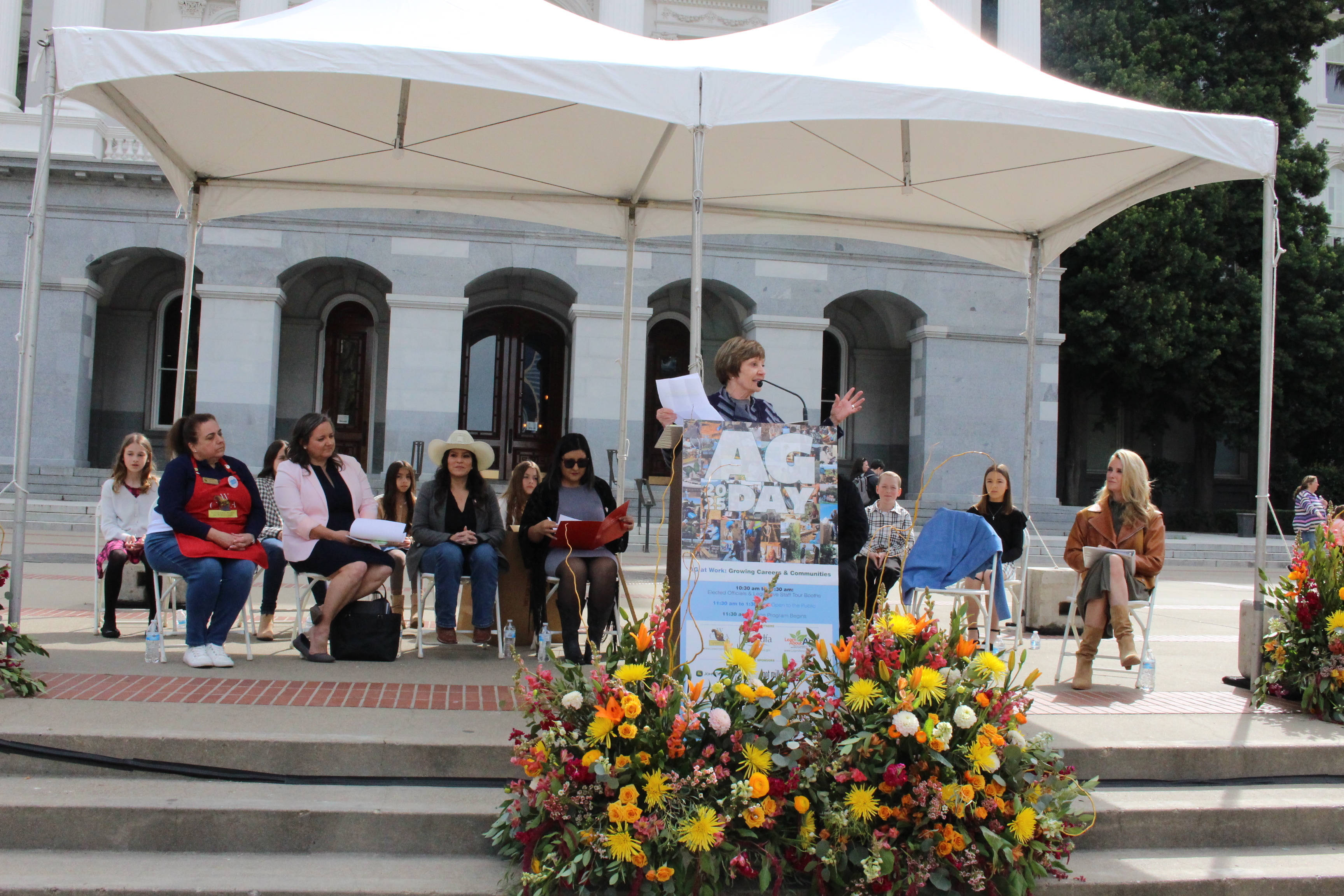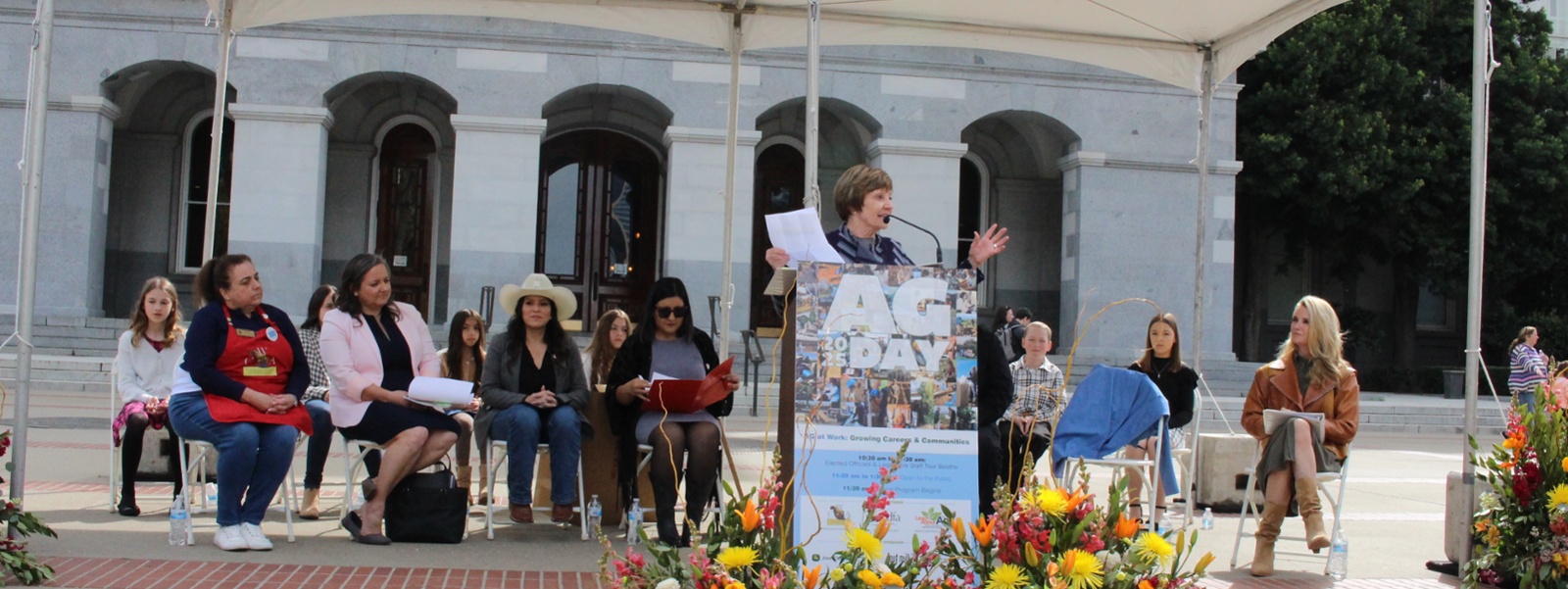On the Record: Karen Ross highlights state's agricultural priorities

California Department of Food and Agriculture Secretary Karen Ross addresses attendees of Ag Day, held annually in March, to celebrate the state’s bounty and recognize farmers and ranchers.
Photo/Christine Souza

• Karen Ross is secretary of the California Department of Food and Agriculture, a position she has held since 2011, with reappointment by Gov. Gavin Newsom in 2019. She has dedicated her life to advancing agriculture, sustainability, nutrition and agricultural education while maintaining essential programs to safeguard agriculture, including pest and disease prevention. Secretary Ross responded to questions during an interview with Ag Alert®. The below conversation was edited for length and clarity.
What are your top priorities at CDFA? Our priorities include the fundamental services we provide, especially pest and disease prevention, food safety and standards inspections. These are critical areas where we must maintain strong funding, scientific expertise and modern laboratory diagnostics. As costs go up, it puts additional stress on the operating budget for farmers and ranchers, so we are very committed to doing the work that we do for farmers in the most cost-effective way possible. One of my biggest priorities is early collaboration with sister agencies. By bringing in our department’s scientific and agronomic expertise early on, we can suggest alternative, science-based approaches to achieving environmental goals.
What are some of the biggest challenges and opportunities facing California agriculture? Even in these challenging and uncertain times, we are making sure that we continue to build export markets for our specialty crops and for dairy. We are equally focused on strengthening our local food systems. Our $85 million investment in farm-to-school programs during the past four years has reached almost 3 million children. In terms of the next generation of agriculture, we want to make sure that we can equip our talented existing workforce with the skills to be a part of that transition to more technology and automation in the future.
What issues keep you up at night when you think about California agriculture? The extreme events and the disruption in supply chains, and also the water situation. I, like the governor, would love to see the breaking of the ground on Sites Reservoir but also to accelerate more groundwater recharge for our water security. I’m concerned about the issues that many farmers worry about: How do I maintain profitability? It is crucial that we understand where we can help provide relief or more efficient, effective ways of doing things. It’s hugely important for our landscape and our climate goals to keep people on the land and for families in rural communities to have a thriving agricultural sector.
Photo/California Department of Food and Agriculture
What is the status of the CDFA 2025-26 budget? We are grateful that the governor’s May Revise proposal includes a critical investment in updating our emergency animal disease and public health program to ensure more rapid response and effective biosecurity prevention measures to outbreaks like avian influenza. We have taken great care to minimize the impact of the reductions we have taken to ensure core functions are maintained. We are evaluating the best approach for some remaining unallocated cuts and will be engaging with stakeholders in the process.
With a new administration in Washington, D.C., how is CDFA navigating changes in federal policy? For me, agriculture has never been about partisan politics. We’re all here to serve farmers and ranchers and make sure that the American people have healthy, nutritious food. I’m very enthused about the emphasis on health and nutrition. As for opportunities, U.S. Department of Agriculture Secretary Brooke Rollins is very focused on farmer and rancher profitability, and we want to make sure that specialty crops are high on her radar screen. We’re very hopeful that she will visit California soon.
How is CDFA helping producers be more sustainable? I’m excited about the work we’re doing positioning farmers as part of the solution to achieving climate resiliency on farms in what we call climate-smart programs, whether it is healthy soils, water-use efficiency or partnering with our dairy farmers to reduce methane emissions with dairy digesters. We’re providing seamless delivery of information about grants and technical assistance to help more farmers participate, including in programs such as the Environmental Quality Incentives Program.
What do you want to accomplish before the end of this administration? I want to make sure that new or well established programs will continue long after I was here. Those programs include what we did to create alternatives to the nutrient management challenges and our work with the dairy sector and state and federal agencies to get dairy digester technology deployed. I’m also really hopeful we can get a strong climate resiliency strategy. We’ll have that out for comment shortly to really show the roadmap of continued investment.
What is the most rewarding part of your job? It is the people—the people in agriculture and what I see in my own staff—dedicated people who are passionate about agriculture. The best day is any day I get to meet the youth—FFA, 4-H and the young kids discovering Ag in the Classroom, and the teachers who support them. I feel very lucky to be able to do this job with the people that I work with and I work for.




